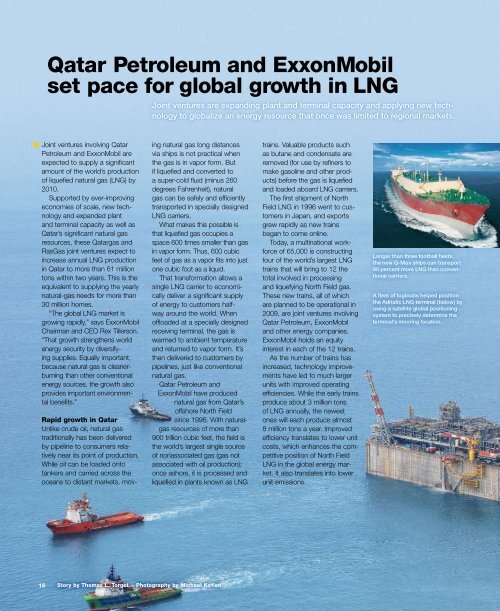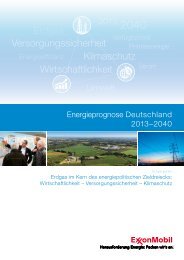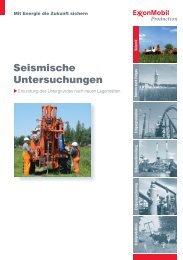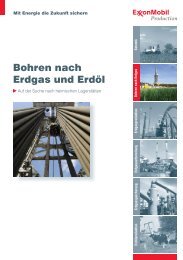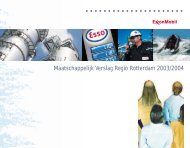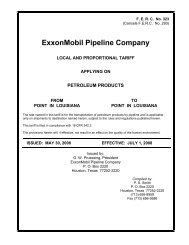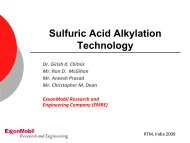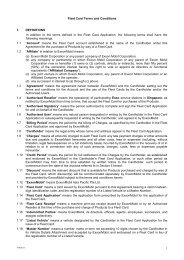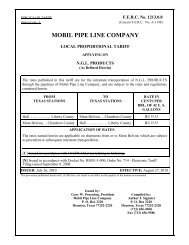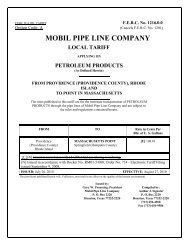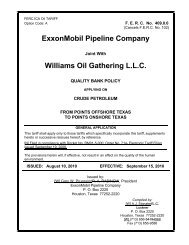Number 4 - ExxonMobil in the UK
Number 4 - ExxonMobil in the UK
Number 4 - ExxonMobil in the UK
Create successful ePaper yourself
Turn your PDF publications into a flip-book with our unique Google optimized e-Paper software.
15<br />
Qatar Petroleum and <strong>ExxonMobil</strong><br />
set pace for global growth <strong>in</strong> LNG<br />
Jo<strong>in</strong>t ventures <strong>in</strong>volv<strong>in</strong>g Qatar<br />
Petroleum and <strong>ExxonMobil</strong> are<br />
expected to supply a significant<br />
amount of <strong>the</strong> world’s production<br />
of liquefied natural gas (LNG) by<br />
2010.<br />
Supported by ever-improv<strong>in</strong>g<br />
economies of scale, new technology<br />
and expanded plant<br />
and term<strong>in</strong>al capacity as well as<br />
Qatar’s significant natural gas<br />
resources, <strong>the</strong>se Qatargas and<br />
RasGas jo<strong>in</strong>t ventures expect to<br />
<strong>in</strong>crease annual LNG production<br />
<strong>in</strong> Qatar to more than 61 million<br />
tons with<strong>in</strong> two years. This is <strong>the</strong><br />
equivalent to supply<strong>in</strong>g <strong>the</strong> yearly<br />
natural-gas needs for more than<br />
30 million homes.<br />
“The global LNG market is<br />
grow<strong>in</strong>g rapidly,” says <strong>ExxonMobil</strong><br />
Chairman and CEO Rex Tillerson.<br />
“That growth streng<strong>the</strong>ns world<br />
energy security by diversify<strong>in</strong>g<br />
supplies. Equally important,<br />
because natural gas is cleanerburn<strong>in</strong>g<br />
than o<strong>the</strong>r conventional<br />
energy sources, <strong>the</strong> growth also<br />
provides important environmental<br />
benefits.”<br />
Rapid growth <strong>in</strong> Qatar<br />
Unlike crude oil, natural gas<br />
traditionally has been delivered<br />
by pipel<strong>in</strong>e to consumers relatively<br />
near its po<strong>in</strong>t of production.<br />
While oil can be loaded onto<br />
tankers and carried across <strong>the</strong><br />
oceans to distant markets, mov-<br />
<strong>in</strong>g natural gas long distances<br />
via ships is not practical when<br />
<strong>the</strong> gas is <strong>in</strong> vapor form. But<br />
if liquefied and converted to<br />
a super-cold fluid (m<strong>in</strong>us 260<br />
degrees Fahrenheit), natural<br />
gas can be safely and efficiently<br />
transported <strong>in</strong> specially designed<br />
LNG carriers.<br />
What makes this possible is<br />
that liquefied gas occupies a<br />
space 600 times smaller than gas<br />
<strong>in</strong> vapor form. Thus, 600 cubic<br />
feet of gas as a vapor fits <strong>in</strong>to just<br />
one cubic foot as a liquid.<br />
That transformation allows a<br />
s<strong>in</strong>gle LNG carrier to economically<br />
deliver a significant supply<br />
of energy to customers halfway<br />
around <strong>the</strong> world. When<br />
offloaded at a specially designed<br />
receiv<strong>in</strong>g term<strong>in</strong>al, <strong>the</strong> gas is<br />
warmed to ambient temperature<br />
and returned to vapor form. It’s<br />
<strong>the</strong>n delivered to customers by<br />
pipel<strong>in</strong>es, just like conventional<br />
natural gas.<br />
Qatar Petroleum and<br />
<strong>ExxonMobil</strong> have produced<br />
natural gas from Qatar’s<br />
offshore North Field<br />
s<strong>in</strong>ce 1996. With naturalgas<br />
resources of more than<br />
900 trillion cubic feet, <strong>the</strong> field is<br />
<strong>the</strong> world’s largest s<strong>in</strong>gle source<br />
of nonassociated gas (gas not<br />
associated with oil production);<br />
once ashore, it is processed and<br />
liquefied <strong>in</strong> plants known as LNG<br />
Story by Thomas L. Torget Photography by Michael Kotlen<br />
Jo<strong>in</strong>t ventures are expand<strong>in</strong>g plant and term<strong>in</strong>al capacity and apply<strong>in</strong>g new technology<br />
to globalize an energy resource that once was limited to regional markets.<br />
tra<strong>in</strong>s. Valuable products such<br />
as butane and condensate are<br />
removed (for use by ref<strong>in</strong>ers to<br />
make gasol<strong>in</strong>e and o<strong>the</strong>r products)<br />
before <strong>the</strong> gas is liquefied<br />
and loaded aboard LNG carriers.<br />
The first shipment of North<br />
Field LNG <strong>in</strong> 1996 went to customers<br />
<strong>in</strong> Japan, and exports<br />
grew rapidly as new tra<strong>in</strong>s<br />
began to come onl<strong>in</strong>e.<br />
Today, a mult<strong>in</strong>ational workforce<br />
of 65,000 is construct<strong>in</strong>g<br />
four of <strong>the</strong> world’s largest LNG<br />
tra<strong>in</strong>s that will br<strong>in</strong>g to 12 <strong>the</strong><br />
total <strong>in</strong>volved <strong>in</strong> process<strong>in</strong>g<br />
and liquefy<strong>in</strong>g North Field gas.<br />
These new tra<strong>in</strong>s, all of which<br />
are planned to be operational <strong>in</strong><br />
2009, are jo<strong>in</strong>t ventures <strong>in</strong>volv<strong>in</strong>g<br />
Qatar Petroleum, <strong>ExxonMobil</strong><br />
and o<strong>the</strong>r energy companies.<br />
<strong>ExxonMobil</strong> holds an equity<br />
<strong>in</strong>terest <strong>in</strong> each of <strong>the</strong> 12 tra<strong>in</strong>s.<br />
As <strong>the</strong> number of tra<strong>in</strong>s has<br />
<strong>in</strong>creased, technology improvements<br />
have led to much larger<br />
units with improved operat<strong>in</strong>g<br />
efficiencies. While <strong>the</strong> early tra<strong>in</strong>s<br />
produce about 3 million tons<br />
of LNG annually, <strong>the</strong> newest<br />
ones will each produce almost<br />
8 million tons a year. Improved<br />
efficiency translates to lower unit<br />
costs, which enhances <strong>the</strong> competitive<br />
position of North Field<br />
LNG <strong>in</strong> <strong>the</strong> global energy market.<br />
It also translates <strong>in</strong>to lower<br />
unit emissions.<br />
Longer than three football fields,<br />
<strong>the</strong> new Q-Max ships can transport<br />
80 percent more LNG than conventional<br />
carriers.<br />
A fleet of tugboats helped position<br />
<strong>the</strong> Adriatic LNG term<strong>in</strong>al (below) by<br />
us<strong>in</strong>g a satellite global position<strong>in</strong>g<br />
system to precisely determ<strong>in</strong>e <strong>the</strong><br />
term<strong>in</strong>al’s moor<strong>in</strong>g location.


